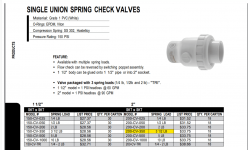Okay....so because I'm paranoid and don't want to risk my heater starving for water again...and because I like to tinker with stuff....I did some research on the proper flow switch and thought I'd document it here since I see it mentioned in several other threads, but haven't seen a project documented here where the pressure sensor was swapped out for a flow switch. Below is the email I received from Harwil. I ordered the switch today and will document the installation here so that future folks have something to refer to. I've also attached the flow switch data sheet for the recommended switch here.
======================================================================================
Hi Wes,
A flow switch that is commonly used for that application is our Q-8N series flow switch.
The part number I would recommend based on plumbing size and flow rate is Q-8N/2/2/A/VITON.
This flow switch is an adjustable flow switch with an ON set point at minimum is 44 gpm and can be adjusted up to 65 gpm in a 2” pipe.
Attached is a data sheet.
The current price for the flow switch is $148.76 each.
We do have a minimum order value of $150, so either 2 units would need to be ordered or we can round up to $150.
You are welcome to purchase direct from Harwil. For purchases we accept Visa, Mastercard, and American Express.
The shipper we use is UPS, if you have an account with UPS we can use that to ship with or just add the cost to the order total.
The email to send orders to is:
[email protected]
If you have any questions just let me know.
Best Regards,
Please know your ordering from us is tantamount to reading and accepting our Standard Terms & Conditions which can be found at the link below.
Harwil Standard Terms and Conditions
From: Wesley Gipe
Sent: Saturday, May 28, 2022 6:29 AM
To: Orders <
[email protected]>
Subject: Which Flow Switch?
Hello,
I have a residential inground pool with a Pentair MasterTemp 4000BTU heater that I installed last year. These heaters have a pressure switch to sense flow, and for a number of reasons, I’d like to replace that with an inline flow switch. The heater manual shows 45GPM for minimum flow to operate. My plan is to place a threaded in the 2” PVC line to hold the flow switch and run the leads to the control board of the heater.
Based on that application, could you suggest and provide pricing for the flow switch that would be best for that application? Thanks!
Wes





















